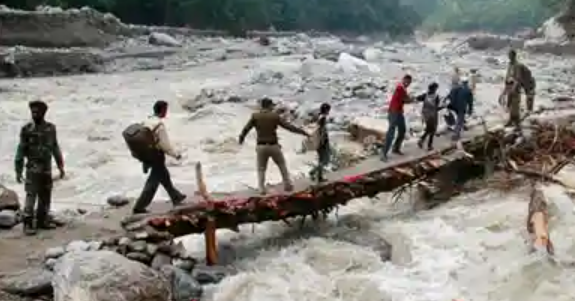Although the Supreme Court took Suo moto (on its own motion) cognizance of the 2013 Kedarnath cloudburst and flooding that killed over 5,000 people and an expert committee warned as early as in 2014 that hydroelectric projects could pose a disaster risk to the state, Uttarakhand is still pursuing the construction of hydroelectric projects and dams.
This is obvious from an affidavit filed in the SC by the Uttarakhand government on August 28, 2020 in response to an appeal by developers of a hydroelectric project on the Alaknanda river to resume operations following a stay imposed on all hydroelectric projects in the state.
The affidavit, seen by HT, says: “It may be respectfully reiterated…that the Uttarakhand government has been facing acute power shortage in recent times and has been forced to purchase electricity amounting to ₹1,000 crore annually, casting an additional burden on the finances of the hilly state…”
The Uttarakhand government and the Union environment ministry still don’t have a policy on hydroelectric projects and dams in the state.
The SC, in its August 13, 2013 order, ruled that no new hydroelectrical power projects should be set up in the state. In all, 69 projects were envisaged in the region, and 24 were granted environmental clearance. SC sought a detailed and scientific assessment of the cumulative impact of hydropower plants in the state.
Following the SC order, a committee headed by Ravi Chopra, director of the People’s Science Institute, submitted a detailed report which warned that a glacial retreat in the state, coupled with structures built for hydroelectricity generation and dams, could lead to large-scale disasters downstream.
The Union environment ministry, in its December 17, 2014 affidavit, also took note of the findings of the Chopra committee report. The affidavit, seen by HT, acknowledged that upper reaches of the state above 2,200 meters were extremely prone to landslides and were located in seismic zones.
The ministry sought to study the seismological vulnerability, cloudbursts caused by climate change and advise on the location, size and design of future hydroelectric projects.
“We had said in our report that the region above 2,000 meters in Uttarakhand in the valleys is not suited for hydroelectric projects. when glaciers recede, there can be a lot of debris and moraines that flow down. Huge boulders also come along. There appears to have been an avalanche and a glacial lake outburst in the Rishi Ganga valley and, as expected, debris and huge boulders smashed into the Tapovan dam,” Chopra said on Sunday after the massive inundation in Uttarakhand’s Rishi Ganga valley caused by a suspected glacial lake outburst flood (GLOF)
But the environment ministry did not take on board the Chopra committee’s recommendations om their entirety. After six of 24 hydroelectric projects were impleaded in the matter of revoking a stay on hydroelectric plants, the SC suggests setting up another panel to consider the case of the projects.
A committee headed by Vinod Tare of the Indian Institute of Technology, Kanpur was set up to review these six projects; the panel submitted a report that the six projects shouldn’t be allowed. The environment ministry recommended setting up another committee to look into the issue, this time headed by BP Das, who used to be a member of an expert appraisal committee (EAC) that had cleared some of the six projects in his tenure. The panel recommended certain hydropower projects with design modifications.
“The Ravi Chopra committee report has been in limbo since then because the environment ministry kept forming committees to ensure the six hydropower projects get to resume work. Not just dams and hydroelectric projects, now extensive slope cutting and deforestation have added to extreme vulnerability of Uttarakhand to climate change impacts,” said Mallika Bhanot of Ganga Ahvaan.
“To say that today’s Rishi Ganga disaster is a natural disaster or God’s act is the biggest lie. The state and Centre have brought this disaster on the people. In 2014, our report had clearly highlighted that dams and hydropower projects are not suited for this terrain and after that SC stayed 24 projects. If not for that stay, today there would have been lakhs of deaths because most of those projects are located upstream and downstream of the Rishi Ganga valley. The government has no decision on cancelling hydropower projects completely. They have also felled lakhs of trees in the char dham ghati (region), cut hill slopes which has made locals even more vulnerable,” said Hemant Dhyani, an environmentalist and member of the Ravi Chopra Committee.
“The fact that the Union environment ministry has granted environmental clearance to Lakhwar dam on Yamuna shows they want to build more dams. So expecting a policy on cancelling all dams and hydropower projects is futile. The SC, following the 2013 disaster (in Kedarnath) had stopped all dams in Uttarakhand, then they reduced the scope of the stay to Ganga while projects were allowed on the Yamuna, Kali etc. Despite the Ravi Chopra committee’s’ clear-cut findings, we didn’t learn a lesson. How many wake-up calls do we need? I can tell you if the Lakh war dam breaks, Delhi has had it. Its entire population will be impacted. No dams or other structures should be allowed in the Himalayas now,” said Manoj Mishra, convener of the Yamuna Jiye Abhiyan.




